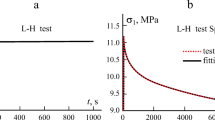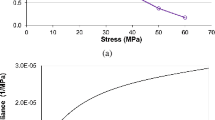Abstract
We investigated how preconditioning history and specimen recovery time affect the accuracy of measurements of mechanical properties obtained from sequential, repeated materials testing of porcine aortic valve (PAV) cusps. Strain history protocols were modeled by quasilinear viscoelastic theory and the results compared with the experimental data. Assuming that the model was predictive, the accuracy of predicting experimental data was related to the suitability of the materials testing protocol. We found that the preconditioned state of the PAV material was not unique but was a function of the deformation history that had occurred before the preconditioning cycles. Preconditioning without an adequate rest period between tests increased predictive errors, whereas allowing the material to rest without preconditioning reduced errors. Modeling more of the strain history reduced errors for specimens briefly rested between tests but had no impact on specimens with long rest periods. The smallest predictive errors were obtained for a loading protocol with a 24 h specimen recovery period followed by material preconditioning. We recommend the use of this protocol for estimating material properties of PAV tissues. © 2000 Biomedical Engineering Society.
PAC00: 8719Rr, 8780-y
Similar content being viewed by others
REFERENCES
Best, T. M., J. McElhaney, W. E. Garrett, Jr., and B. S. Myers.Characterization of the passive responses of live skeletal muscle using the quasi-linear theory of viscoelasticity. J. Biomech.27:413–419, 1994.
Carew, E. O., E. A. Talman, D. R. Boughner, and I.Vesely. Quasi-Linear Viscoelastic theory applied to internal shearing of porcine aortic valve leaflets. J. Biomech. Eng.121:386–392, 1999.
Fung, Y. C. Biomechanics: Mechanical Properties ofLiving Tissues, 2nd ed. New York: Springer, 1993, pp. 277–292.
Haut, R. C., and R.W. Little. A constitutive equation for collagen fibers. J. Biomech. 5:423–430, 1972.
Huyghe, J. M., D. H. van Campen, T. Arts, and R. M. Heethaar. The constitutive behaviour ofpassive heart muscle tissue: A quasi-linear viscoelastic formulation. J. Biomech. 24:841–849, 1991.
Kwan, M. K., T. H-C. Lin, and S. L-Y. Woo. On the viscoelastic properties of the anteromedialbundle of the anterior cruciate ligament. J. Biomech.26:447–452, 1993.
Lee, J. M., D.W. Courtman, and D. R. Boughner. The glutaraldehyde-stabilized porcine aortic valve xenograft. I. Tensile viscoelastic properties of the fresh leaflet material. J. Biomed. Mater. Res.18:61–77, 1984.
Myers, B. S., J. H. McElhaney, and B. J. Doherty. The viscoelastic responses of the humancervical spine in torsion: experimental limitations of quasi-linear theory, and a method for reducing these effects. J. Biomech.24:811–817, 1991.
Pinto, J. G., and P. J. Patitucci. Visco-elasticity ofpassive cardiac muscle. J. Biomech. Eng.102:57–61, 1980.
Rousseau, E. P. M., A.A. H. J. Sauren, M. C. van Hout, and A. A. van Steenhoven. Elastic and viscoelastic material behaviour of fresh and glutaraldehyde-treated porcine aortic valve tissue. J. Biomech.16:339–348, 1983.
Sauren, A. A. H. J., M. C. van Hout, A. A. van Steenhoven, F. E. Veldpaus, and J. D. Janssen.The mechanical properties of porcine aortic valve tissues. J. Biomech.16:327–337, 1983.
Talman, E., and D. Boughner. Strain rate affects viscoelastic measurements on porcine aortic heartvalve tissue tested in shear. ASME Bioeng. Div. Publ. BED36:55–56, 1997.
Vesely, I.A mechanism for the decrease in stiffness of bioprosthetic heart valve tissues after cross-linking. ASAIO J. 42:993–999, 1996.
Vesely, I., and J. E. Barber. The role of tissue preconditioning inmeasuring stress relaxation behavior of heart valve tissues. Proceedings of the 3rd World Congress of Biomechanics, Sapporo, Japan, 1998, p. 193
Vesely, I., and R. Brewer Preconditioningdoes not reset the strain history of uniaxially tested, porcine aortic valve tissues ASME Bioeng. Div. Publ. BED36:57–58, 1997.
Vesely, I., and A. Lozon. Natural preload of aortic valve leafletcomponents during glutaraldehyde fixation: effects on tissue mechanics. J. Biomech.26:121–131, 1993.
Woo, S. L-Y., M. A. Gomez, and W. H. Akeson. The time and history-dependentviscoelastic properties of the canine medial collateral ligament. J. Biomech. Eng.103:293–298, 1981.
Woo, S. L-Y., B. R. Simon, S. C. Kuei, and W. H. Akeson. Quasi-linear viscoelastic propertiesof normal articular cartilage. J. Biomech. Eng.102:85–90, 1980.
Author information
Authors and Affiliations
Rights and permissions
About this article
Cite this article
Carew, E.O., Barber, J.E. & Vesely, I. Role of Preconditioning and Recovery Time in Repeated Testing of Aortic Valve Tissues: Validation Through Quasilinear Viscoelastic Theory. Annals of Biomedical Engineering 28, 1093–1100 (2000). https://doi.org/10.1114/1.1310221
Issue Date:
DOI: https://doi.org/10.1114/1.1310221




